Manufacturers add care labels to their garments, so we know how to launder them. The only problem is they use symbols. It can be like trying to read hieroglyphics. Especially if you are new to doing the laundry. How do you know what they mean? Don’t worry. I’m here to show you how with this complete guide to care labels.
Care labels give information on garment care. Located inside the collar or at the side seam, they are attached or printed onto the fabric. They use symbols to represent different care methods. A washtub with a hand means hand wash only. While a circle stands for dry clean. Any symbol with an “X” means do not use that method.
In this article, you’ll learn about the different types of care labels on garments. You’ll discover what information is printed on them. As well as learn how to read laundry care symbols.
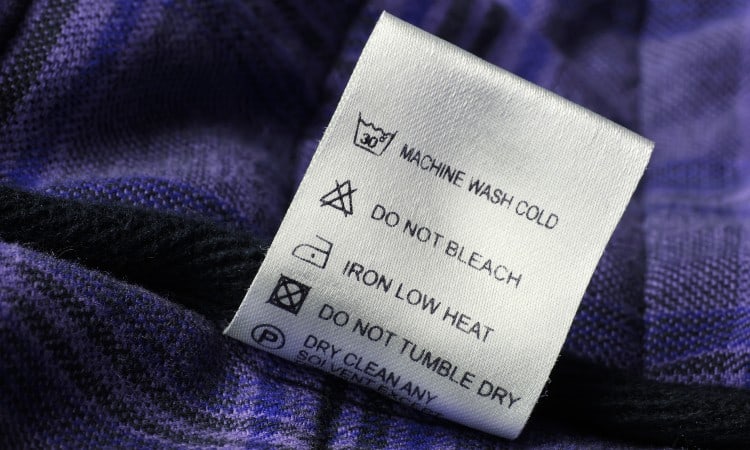
Quick Navigation
Different Types of Labels Used in Garments
There are several different types of labels that can be found in garments. Also known as tags, they can be found in different locations. Either at the back of your collar, hanging from a waistband, or tucked into a side seam.
Sometimes there are two or three separate labels, all flapping about like little flags sticking out of your garment. They can be annoying as they scratch your skin. Or worse, stick out of your collar at the back for all to see.
It’s not just garments, either. Pillows, comforters, sofas, blankets, and carpets can all have labels attached. Anything that contains yarn or fabric fibers will have some kind of informational label attached to it.
These tag-shaped nuggets of wisdom aren’t restricted to flappy pieces of fabric sewn into your clothes. Some manufacturers print their information directly onto the item’s fabric, particularly in t-shirts and sweaters. But what are care labels and why are there so many?
Manufacturers use labels to let us know important information about a specific item. One of the main reasons is to comply with legislation. In most parts of the world, it’s a legal requirement to state the fiber content within a garment. This is for your safety. You could have an allergy to certain materials, so it’s important to know what’s in a product before you buy it.
Another reason is brand identity, trust, and loyalty. Manufacturers go through a lot of trouble to test the materials they use. They want to ensure you know how to look after your garment or pillow. An item’s longevity is important to the success of the brand.
With so much data to get across to you, it’s no wonder there are so many labels. Let’s take a look at them so you can see the difference.
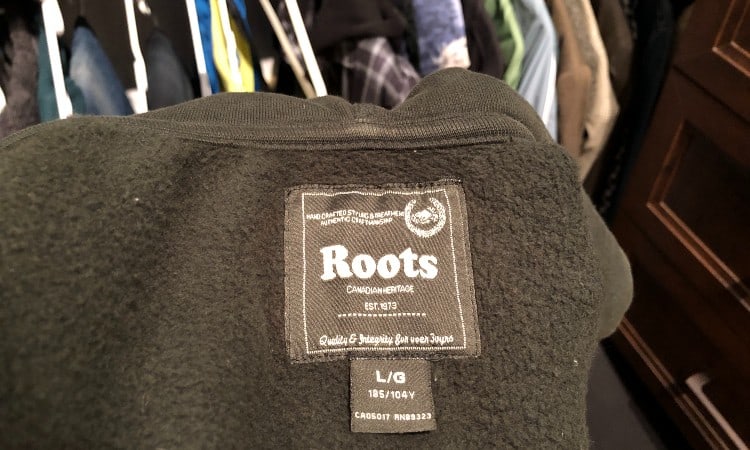
1. Brand Label
It doesn’t matter if you’re purchasing a well-known brand or a store’s own. There will be some kind of name tag on the garment. All manufacturers like you to know whose products you are buying.
Brand labels can be unobtrusive and part of the main care label. Others can be standalone brand logos either inside the garment or printed in full view on the outside. The Nike tick on a pair of sneakers, for instance. Or the Wrangler badge on the back pocket of your jeans.
These labels give you buying confidence. If you’re like me, you stick with brand names you know and can trust. When you see your favorite brand emblazoned on clothing, it can greatly influence your decision to buy the garment.
2. Flag Label
Similar to the brand label, a flag label is usually smaller and added to a garment as part of the design. You’ll find them poking out of side seams. They can also be put on pocket flaps. With the appearance of tiny flags, this option is more subtle than the larger brand label.
Flag labels aren’t restricted to advertising the brand. They can also be used to draw attention to the country of origin and proudly state the environmental credentials of the clothing.
3. Size Label
The size of the item is one of the most important pieces of information you need to know about a garment. It might be the cutest t-shirt ever, but it’s no good to you if you don’t know if it’ll fit you.
Sometimes the size is indicated on the same label as the brand name. Or it will be at the top of the washing instructions. Wherever it’s located, it should state the size in either inches or centimeters. You’ll also find letters to denote the size. The letter S is used to indicate small. While XL shows, the garment is extra large.
4. Manufacturer’s ID Label
This label is slightly different from the brand label for retailers or commercial buyers. It gives the manufacturer’s registered identification number or RN. The reason this is shown on clothes, as well as the brand, is down to space.
Sometimes the name of the manufacturer differs from the brand name. Take Wrangler, for instance. Wrangler is the brand name, and the company that makes Wrangler jeans is called Kontoor Brands Inc.
While you and I want to see the brand, commercial buyers want to see the company details. Particularly their address. So Kontoor Brand Inc prints their RN on either the care label or a smaller flag label just to the side of it.
Not only does this link back to the makers of the clothing range, but it also helps identify the importers and the outlet responsible for selling the clothing.
5. Batch Mark Label
This one is an internal quality control label. The manufacturing company uses batch marks or labels to identify a specific clothing run.
As an example, let’s say a garment has arrived at quality control with a zipper missing. The batch mark can trace the product back through the factory to the production line that caused the blooper. The mistake can be fixed and steps can be taken to prevent the same error in future runs.
It’s not a label you need to see; not all manufacturers leave them on. If you see one, it will most likely be located at the side seam. It could even be a simple sticker with a set of red numbers on it.
6. Special Label
When your garment has a special label, the manufacturer highlights an exceptional feature. This could be anything from being waterproof to containing organic cotton. It might even state that the garment is flammable.
Special labels are used on clothing such as children’s pajamas when the material hasn’t been treated with a fire retardant coating. Or on leather items, to let you know, they are genuine and not made from pleather or faux leather.
What Is a Care Label?
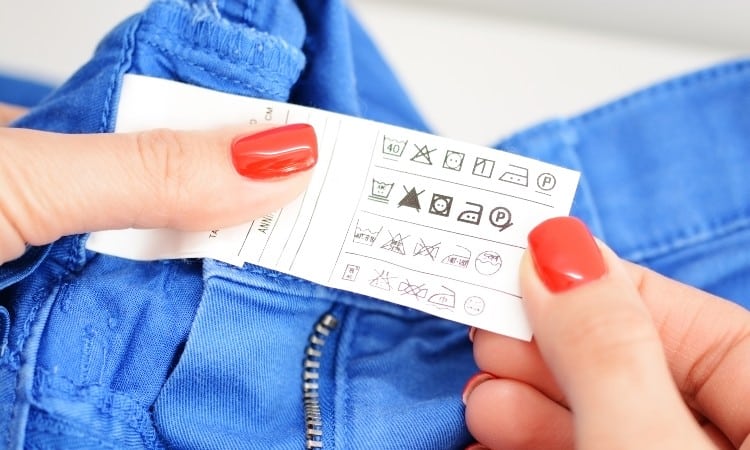
So far, we’ve looked at the general information labels you can find on apparel throughout the world. While it’s nice to know the brand of the garment and the place of origin, there is something far more important that you need to know.
Owning a pair of jeans with a label stating, “Made in the USA”, is great. But it isn’t going to help you look after your clothing. To do that, you need to turn to one more label manufacturers put on their garments. From a consumer’s point of view, it’s probably the most useful. That label is known as the care label.
Unlike the other labels attached to your clothing, the care label lets you know how to care for your garment. It will also tell you what your garment is made from.
Knowing the fiber content of your clothing helps you in two ways. The first is the difference between a garment made from synthetic or natural fiber.
Synthetic fibers can cause allergic reactions. They are also not advisable for use with babies or young children. In both situations, you need to know what fiber you are dealing with to make the best choice. Identifying a garment made from 100% cotton can go a long way to keeping you and your loved ones safe and comfortable.
Then, there is caring for your garment. Identifying the materials that go into your clothing isn’t the only information you’ll find on your care label. You’ll also find washing instructions.
Different materials need a different approach in the laundry room. Some need a gentle hand. Others need to be kept away from bleach. Using a mixture of words and symbols, care labels will make sure you know what type of garment you are dealing with and how you should treat it.
Importance of Care Labels on Clothing
Care labels on clothing are incredibly important. They are essential to the longevity of your garment. They ensure that you know how to care for your clothing correctly. But more than that, they also help you decide if a specific garment is a right choice.
Not following the instructions on a care label is one of the main reasons clothing gets ruined during the washing process. This can be more than just annoying. It could also cost you money.
Clothing, even fast fashion items intended to last one season, can be expensive, especially if they are designer items or made from pricey fabrics like suede.
The last thing you want to do with a mud-splattered suede jacket is put it in the washing machine, which you might do if you don’t check the care label. Suede is easily damaged by water, so items that use suede are usually dry clean only.
It isn’t just special fabrics like suede that can be ruined in the laundry room. Anything with a special finish, like a waterproof down jacket or a delicate lace handkerchief, will wind up damaged if you don’t treat them properly. Even a basic cotton shirt can shrink if you don’t follow the instructions on the care label.
Care labels are indispensable. They work the same way as the manual with your new phone, albeit in a smaller format. The care label provides you with everything you need to know about your garment and how to care for it. Following the instructions on the label will keep your clothing looking great and lasting longer.
Do All Garments Have Care Labels?
Yes, all garments have some form of care label or notice attached. Most items made out of fabric will have a care label. They don’t all look the same, though. There is a variety of shapes and sizes. Even the location on a garment can differ.
You’ll even find garments that don’t have a separate label. Instead, the care information is printed on the fabric at the back of an item. This is particularly popular on shirts or sweaters.
Care labels are notorious for being scratchy. Combine this with the delicate skin around your neck, and you could find that your care label causes you more irritation. Both in the constant itching at your neck and the annoyance it causes.
Having the information printed on the inside of your shirt removes the need for a scratchy, flappy tag. It also ensures the care label stays with the garment instead of getting cut off with a vengeful pair of scissors.
However, there are some garments that can’t have permanent tags or information printed on them. These are items where the presence of a label would hinder or interfere with the performance of the garment. But even so, they must have detachable instructions provided with them.
What Do the Symbols Mean on Care Labels?
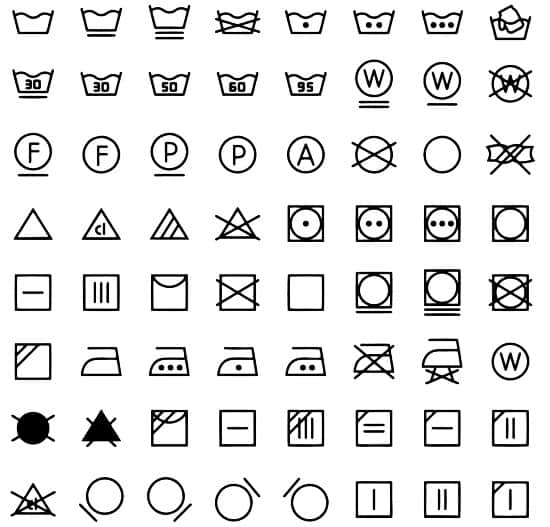
We’ve all seen the weird little hieroglyphic symbols on care labels. Reading them can feel like you are playing some kind of guessing game whenever you do your laundry. You’ve got dots and squares, lines and triangles.
It can leave you wondering why manufacturers don’t write down what they want you to do. Instead of making you feel flummoxed by a picture that looks like candy with a cross through it.
The thing is, they can’t use words on their own. There are too many different washing temperatures, spin cycles, and iron settings. Don’t forget the dry clean chemicals, drying options, and whether you can bleach the garment.
Then you need to remember where the garments are sold. Levi’s jeans aren’t exclusive to the US. You can buy them in France, Germany, and in Japan. So now, you need to translate the information into different languages.
Honestly, putting all the variables in longhand on a clothing care label would make it the size of Tolstoy’s “War and Peace”. Could you imagine the irritation that the size of the label would cause to the back of your neck? Not to mention an unsightly bulge!
Being attached to clothing means it’s essential for care labels to be as small as possible. With so much information to give you, manufacturers needed to get creative. So they cured the space issue in an innovative way. One which is recognizable throughout the world.
They took a leaf out of the Egyptians’ book and used hieroglyphics. Although these days, we tend to call them symbols. There are 5 basic symbols that are used internationally as a universal laundry language.
To keep things clear and consistent, manufacturers following the international labeling system always print them in the same order. Let’s take a look at what they are and what they mean.
Symbol Number 1 – The Wash Tub

This one is a picture of a tub or bucket filled with water. This indicates if a garment is washable or not.
Tubs with a large cross on them mean they are not. If the tub has a hand dipping into the water, it means the garment is hand wash only.
Sometimes you’ll see numbers inside the tub. These indicate water temperature and are usually written in Celsius. Or the numbers will be replaced with dots. One dot is equal to 30°C or a cool wash. Three dots would be 50°C or a hot wash.
US labels have lines underneath the tub. These represent the wash cycle you should use. No line means a normal wash, one line is permanent press, and two lines mean a delicate wash.
Remember the candy with a cross through it that I mentioned earlier? Well, you’re likely to see that one in the washing section. However, it’s not a picture of candy. It’s the symbol for “do not wring”.
Symbol Number 2 – The Triangle

This one isn’t immediately obvious. It’s the symbol for bleach. A clear triangle with no other markings indicates a garment can be bleached with either chlorine-based or non-chlorine bleach.
If there is a cross through the triangle, it means you need to keep bleach well away from your garment. Using bleach will cause damage. Diagonal lines inside the triangle tell you that you can only use non-chlorine bleach.
Symbol Number 3 – The Square

Rather than being a square, you need to think of this one as a box, like the shape of your dryer. That’s what it represents. Sometimes you’ll find a circle inside the box reminiscent of the dryer door. This symbol lets you know if your item can be dried by machine.
The little circle inside the box might have dots in it. They show the heat you can use. Three dots means hot, and one dot is cool or low heat. If the circle is black, you can only use the fluff or an air setting.
Lines underneath the box are used to show the setting of the dryer. One line is for permanent press and two indicate a delicate setting.
Should your box look more like an envelope with a curvy line at the top, then it means you should line-dry your garment. Another option for line drying is three vertical lines inside the box. One solid, straight line across the middle of the box lets you know you should dry your item flat.
Sometimes you’ll see two diagonal lines across the top left corner of the box. This is to let you know your item needs to be in the shade.
A box with a cross through it means you can’t dry the item in your tumble dryer. Doing so could cause damage. So the cross indicates a definite no-no.
Symbol Number 4 – The Iron

You don’t need a Ph.D. in hieroglyphics to know this one. It’s instantly recognizable as the picture of an iron. As with the other symbols, a large cross going over the top of it means do not iron your garment.
The iron symbol uses the dot system to indicate the temperature. One dot inside the iron shape means you need to use a low heat setting, while three dots mean you can turn your iron up to hot.
If your iron looks like it has a cross underneath it, you need to be extra careful. Especially if you have a steam iron, this symbol lets you know you can’t use steam on your garment. Make sure your steam setting is switched off.
Symbol Number 5 – The Circle
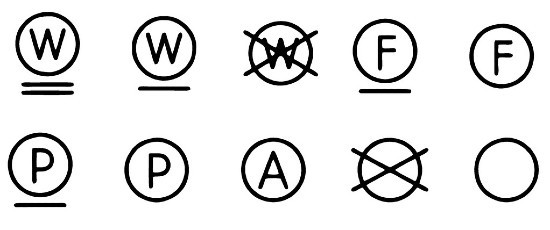
The symbol used to represent dry cleaning is a circle. Most of the information given regarding dry cleaning is intended to be used by a professional dry cleaner. However, you need to know that a circle with a cross-through means the item should not be dry-cleaned.
There will usually be a letter inside the circle. This can be an “A”, a “P”, or an “F”. These letters refer to the cleaning solvents that can be used on the garment. Sometimes the circle will have little lines placed on the outside. This lets the dry cleaning company know the kind of cycle the garment can withstand.
Are Care Labels the Same Around the World?
Mostly yes, the care label symbols are identical around the world, particularly the 5 symbols that represent washing, bleaching, drying, ironing, and dry cleaning.
However, there are slight differences in the information that needs to be shown on labels across the globe. This is mainly down to the difference in legal requirements set by individual countries.
As well as the international system, some areas have their own labeling rules. In fact, there are 5 symbol systems in use around the world today. Let’s take a look at them.
International Care Label System
The “International Association for Textile Care Labelling”, was founded in Paris in 1963. It is governed by a group of nations under the banner of GINETEX. There are 22 member countries spanning Europe, Africa, Asia, and South America.
Their mission is simple. To ensure clear and concise labeling of clothing free from the constraints of any language barriers or potential misinterpretation. The system is designed to streamline the process of textile labeling to an extent that only one system is required.
Aimed at keeping the consumer informed at all times, the system is relatively easy to use. All member countries using the international system print the symbols in the same order. That order is washing, bleaching, drying, ironing, and dry cleaning.
Japanese Care Label System
The Japanese system for care labels has a different order from the international one. Their symbols are printed as washing, bleaching, ironing, dry cleaning, wringing, and drying. Although they use a tub with water to denote washing, theirs represents hand washing.
Items that can be machine washed are marked with a basic pictogram of a washing machine. The water temperature is printed inside the washing machine using Celsius. Sometimes, kanji is used to further explain whether the item should be washed on a gentle or normal cycle.
In the Japanese system, the bleach symbol looks like a conical flask, similar to the type you find in a chemistry lab. For drying, they use a picture of a shirt or tunic. Although they use a circle to denote dry cleaning, it differs from the international symbol. The Japanese version has a wavy line going across the center.
European Care Label System
As many of the countries within Europe are part of GINETEX, it should be no surprise that the European system uses the same symbols as the international one. They even follow the printing order of the international system.
Since 2012, the European system has discontinued using a blackened triangle to indicate, “do not bleach”. These days the symbol is a simple triangle with a cross through it.
Although the drying symbol is a square, there are various options for natural drying methods, including a box with two horizontal lines across the center, with one diagonal line in the top left corner. This symbol means dry flat in the shade.
Canadian Care Label System
Although it is compulsory in Canada to show the fiber content of a garment, manufacturers are not compelled to supply washing instructions. However, they do tend to. But they do so voluntarily.
Originally, the Canadian system was color-coded and used red, amber, and green. Where green means good to go and red means don’t do that. These days, the labels are printed in black and white to align with the US and international systems.
Symbols are printed in the same order as the international system and are identical. Canada has one slight difference from the other systems. It is a legal requirement for any wording to be printed in both English and French.
American Care Label System
There is a legal requirement for items to have some form of care label in the US. It can be either words or symbols, but it must be present on all items and be permanently attached.
On top of that, if the care label isn’t visible while the garment is on display at the store, the information must be put on the packaging. Or there should be an external hang tag. It is an important part of the American system that consumers can see care instructions before purchasing the garment.
These days American care labels use more symbols than words. They use international pictograms and print them as per the internationally recognized order. They also use the dot system to indicate the maximum temperature to use with irons, water, and dryers.
Conclusion
Care labels help you take care of your garments. By using a small selection of symbols, they can tell you everything you need to know, from whether a garment can be washed to the best way to dry it.
Keep this complete guide to care labels close by the next time you do your laundry. It will help you read the symbols quickly and easily.
Did you find this article useful? Do you feel more confident about reading your care label? Let me know in the comments.